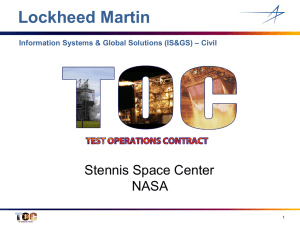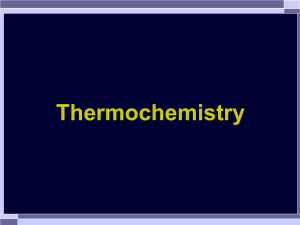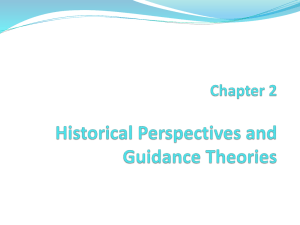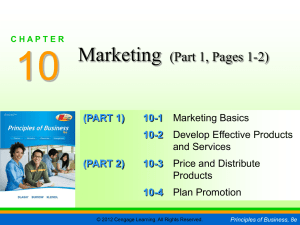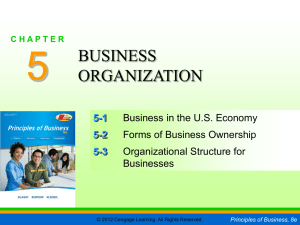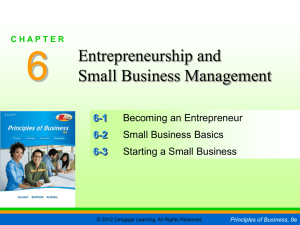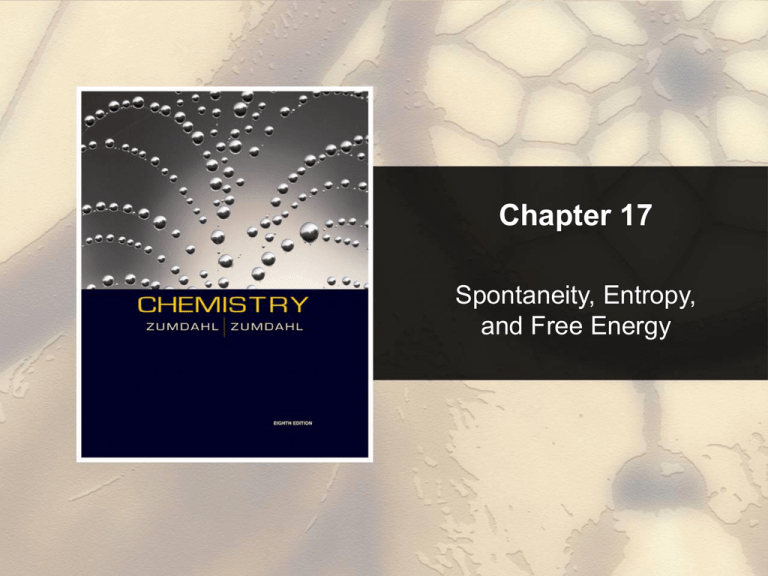
Chapter 17
Spontaneity, Entropy,
and Free Energy
Chapter 17
Table of Contents
17.1
17.2
17.3
17.4
17.5
17.6
17.7
17.8
17.9
Spontaneous Processes and Entropy
Entropy and the Second Law of Thermodynamics
The Effect of Temperature on Spontaneity
Free Energy
Entropy Changes in Chemical Reactions
Free Energy and Chemical Reactions
The Dependence of Free Energy on Pressure
Free Energy and Equilibrium
Free Energy and Work
Copyright © Cengage Learning. All rights reserved
2
Section 17.1
Spontaneous Processes and Entropy
Thermodynamics vs.
Kinetics
•
•
Domain of Kinetics
Rate of a reaction
depends on the
pathway from
reactants to products.
Thermodynamics tells us
whether a reaction is
spontaneous based only
on the properties of
reactants and products.
Return to TOC
Copyright © Cengage Learning. All rights reserved
3
Section 17.1
Spontaneous Processes and Entropy
Spontaneous Processes and Entropy
• Thermodynamics lets us predict whether a
process will occur but gives no information
about the amount of time required for the
process.
• A spontaneous process is one that occurs
without outside intervention.
Return to TOC
Copyright © Cengage Learning. All rights reserved
4
Section 17.1
Spontaneous Processes and Entropy
Concept Check
Consider 2.4 moles of a gas contained in a 4.0
L bulb at a constant temperature of 32°C. This
bulb is connected by a valve to an evacuated
20.0 L bulb. Assume the temperature is
constant.
a) What should happen to the gas when you
open the valve?
Return to TOC
Copyright © Cengage Learning. All rights reserved
5
Section 17.1
Spontaneous Processes and Entropy
Concept Check
Consider 2.4 moles of a gas contained in a 4.0
L bulb at a constant temperature of 32°C. This
bulb is connected by a valve to an evacuated
20.0 L bulb. Assume the temperature is
constant.
b) Calculate H, E, q, and w for the
process you described above.
All are equal to zero.
Return to TOC
Copyright © Cengage Learning. All rights reserved
6
Section 17.1
Spontaneous Processes and Entropy
Concept Check
Consider 2.4 moles of a gas contained in a 4.0
L bulb at a constant temperature of 32°C. This
bulb is connected by a valve to an evacuated
20.0 L bulb. Assume the temperature is
constant.
c) Given your answer to part b, what is the
driving force for the process?
Entropy
Return to TOC
Copyright © Cengage Learning. All rights reserved
7
Section 17.1
Spontaneous Processes and Entropy
The Expansion of An Ideal Gas Into an Evacuated Bulb
Return to TOC
Copyright © Cengage Learning. All rights reserved
8
Section 17.1
Spontaneous Processes and Entropy
Entropy
• The driving force for a spontaneous process is
an increase in the entropy of the universe.
• A measure of molecular randomness or
disorder.
Return to TOC
Copyright © Cengage Learning. All rights reserved
9
Section 17.1
Spontaneous Processes and Entropy
Entropy
• Thermodynamic function that describes the
number of arrangements that are available to a
system existing in a given state.
• Nature spontaneously proceeds toward the
states that have the highest probabilities of
existing.
Return to TOC
Copyright © Cengage Learning. All rights reserved
10
Section 17.1
Spontaneous Processes and Entropy
The Microstates That Give a Particular Arrangement (State)
Return to TOC
Copyright © Cengage Learning. All rights reserved
11
Section 17.1
Spontaneous Processes and Entropy
The Microstates That Give a Particular Arrangement (State)
Return to TOC
Copyright © Cengage Learning. All rights reserved
12
Section 17.1
Spontaneous Processes and Entropy
Positional Entropy
• A gas expands into a vacuum because the
expanded state has the highest positional
probability of states available to the system.
• Therefore: Ssolid < Sliquid << Sgas
Return to TOC
Copyright © Cengage Learning. All rights reserved
13
Section 17.1
Spontaneous Processes and Entropy
Concept Check
Predict the sign of S for each of the
following, and explain:
+ a) The evaporation of alcohol
– b) The freezing of water
– c) Compressing an ideal gas at constant
temperature
+ d) Heating an ideal gas at constant
pressure
+ e) Dissolving NaCl in water
Copyright © Cengage Learning. All rights reserved
Return to TOC
14
Section 17.2
Atomic Masses
Entropy
and the Second Law of Thermodynamics
Second Law of Thermodynamics
• In any spontaneous process there is always an
increase in the entropy of the universe.
• The entropy of the universe is increasing.
• The total energy of the universe is constant, but
the entropy is increasing.
Suniverse = ΔSsystem + ΔSsurroundings
Return to TOC
Copyright © Cengage Learning. All rights reserved
15
Section 17.3
The Effect
Mole of Temperature on Spontaneity
Concept Check
For the process A(l)
A(s), which direction
involves an increase in energy randomness?
Positional randomness? Explain your answer.
As temperature increases/decreases (answer for
both), which takes precedence? Why?
At what temperature is there a balance between
energy randomness and positional randomness?
Return to TOC
Copyright © Cengage Learning. All rights reserved
16
Section 17.3
The Effect
Mole of Temperature on Spontaneity
Concept Check
Describe the following as spontaneous/non-spontaneous/cannot tell,
and explain.
A reaction that is:
a) Exothermic and becomes more positionally random
Spontaneous
b) Exothermic and becomes less positionally random
Cannot tell
a) Endothermic and becomes more positionally random
Cannot tell
a) Endothermic and becomes less positionally random
Not spontaneous
Explain how temperature affects your answers.
Copyright © Cengage Learning. All rights reserved
Return to TOC
17
Section 17.3
The Effect
Mole of Temperature on Spontaneity
ΔSsurr
• The sign of ΔSsurr depends on the direction of
the heat flow.
• The magnitude of ΔSsurr depends on the
temperature.
Return to TOC
Copyright © Cengage Learning. All rights reserved
18
Section 17.3
The Effect
Mole of Temperature on Spontaneity
ΔSsurr
Return to TOC
Copyright © Cengage Learning. All rights reserved
19
Section 17.3
The Effect
Mole of Temperature on Spontaneity
ΔSsurr
Return to TOC
Copyright © Cengage Learning. All rights reserved
20
Section 17.3
The Effect
Mole of Temperature on Spontaneity
ΔSsurr
Heat flow (constant P) = change in enthalpy = ΔH
Ssurr
H
=
T
Return to TOC
Copyright © Cengage Learning. All rights reserved
21
Section 17.3
The Effect
Mole of Temperature on Spontaneity
Interplay of Ssys and Ssurr in Determining the Sign of Suniv
Return to TOC
Copyright © Cengage Learning. All rights reserved
22
Section 17.4
Free Energy
Free Energy (G)
Suniv
G
=
(at constant T and P )
T
• A process (at constant T and P) is spontaneous
in the direction in which the free energy
decreases.
Negative ΔG means positive ΔSuniv.
Return to TOC
Copyright © Cengage Learning. All rights reserved
23
Section 17.4
Free Energy
Free Energy (G)
• ΔG = ΔH – TΔS (at constant T and P)
Return to TOC
Copyright © Cengage Learning. All rights reserved
24
Section 17.4
Free Energy
Concept Check
A liquid is vaporized at its boiling point. Predict
the signs of:
w
–
q
+
H
+
S
+
Ssurr
–
G
0
Explain your answers.
Return to TOC
Copyright © Cengage Learning. All rights reserved
25
Section 17.4
Free Energy
Exercise
The value of Hvaporization of substance X is 45.7
kJ/mol, and its normal boiling point is 72.5°C.
Calculate S, Ssurr, and G for the
vaporization of one mole of this substance at
72.5°C and 1 atm.
S = 132 J/K·mol
Ssurr = -132 J/K·mol
G = 0 kJ/mol
Return to TOC
Copyright © Cengage Learning. All rights reserved
26
Section 17.4
Free Energy
Spontaneous Reactions
Return to TOC
Copyright © Cengage Learning. All rights reserved
27
Section 17.4
Free Energy
Effect of
H and
S on Spontaneity
H
S
Result
+
spontaneous at all temps
+
+
spontaneous at high temps
spontaneous at low temps
+
not spontaneous at any temp
Return to TOC
Copyright © Cengage Learning. All rights reserved
28
Section 17.5
Entropy Changes in Chemical Reactions
Concept Check
Gas A2 reacts with gas B2 to form gas AB at
constant temperature and pressure. The bond
energy of AB is much greater than that of either
reactant.
Predict the signs of:
H
Ssurr
–
+
S
0
Suniv
+
Explain.
Return to TOC
Copyright © Cengage Learning. All rights reserved
29
Section 17.5
Entropy Changes in Chemical Reactions
Third Law of Thermodynamics
• The entropy of a perfect crystal at 0 K is zero.
• The entropy of a substance increases with
temperature.
Return to TOC
Copyright © Cengage Learning. All rights reserved
30
Section 17.5
Entropy Changes in Chemical Reactions
Standard Entropy Values (S°)
• Represent the increase in entropy that occurs
when a substance is heated from 0 K to 298 K
at 1 atm pressure.
ΔS°reaction = ΣnpS°products – ΣnrS°reactants
Return to TOC
Copyright © Cengage Learning. All rights reserved
31
Section 17.5
Entropy Changes in Chemical Reactions
Exercise
Calculate S° for the following reaction:
2Na(s) + 2H2O(l) → 2NaOH(aq) + H2(g)
Given the following information:
S° (J/K·mol)
Na(s)
51
H2O(l)
70
NaOH(aq)
50
H2(g)
131
S°= –11 J/K
Copyright © Cengage Learning. All rights reserved
Return to TOC
32
Section 17.6
Free Energy and Chemical Reactions
Standard Free Energy Change (ΔG°)
• The change in free energy that will occur if the
reactants in their standard states are converted
to the products in their standard states.
ΔG° = ΔH° – TΔS°
ΔG°reaction = ΣnpG°products – ΣnrG°reactants
Return to TOC
Copyright © Cengage Learning. All rights reserved
33
Section 17.6
Free Energy and Chemical Reactions
Concept Check
A stable diatomic molecule spontaneously
forms from its atoms.
Predict the signs of:
H°
S°
–
–
G°
–
Explain.
Return to TOC
Copyright © Cengage Learning. All rights reserved
34
Section 17.6
Free Energy and Chemical Reactions
Concept Check
Consider the following system at
equilibrium at 25°C.
PCl3(g) + Cl2(g)
PCl5(g)
G° = −92.50 kJ
What will happen to the ratio of partial
pressure of PCl5 to partial pressure of PCl3
if the temperature is raised? Explain.
The ratio will decrease.
Copyright © Cengage Learning. All rights reserved
Return to TOC
35
Section 17.7
The Dependence of Free Energy on Pressure
Free Energy and Pressure
G = G° + RT ln(P)
or
ΔG = ΔG° + RT ln(Q)
Return to TOC
Copyright © Cengage Learning. All rights reserved
36
Section 17.7
The Dependence of Free Energy on Pressure
Concept Check
Sketch graphs of:
1. G vs. P
2. H vs. P
3. ln(K) vs. 1/T (for both endothermic and
exothermic cases)
Return to TOC
Copyright © Cengage Learning. All rights reserved
37
Section 17.7
The Dependence of Free Energy on Pressure
The Meaning of ΔG for a Chemical Reaction
• A system can achieve the lowest possible free
energy by going to equilibrium, not by going to
completion.
Return to TOC
Copyright © Cengage Learning. All rights reserved
38
Section 17.8
Free Energy and Equilibrium
• The equilibrium point occurs at the lowest value
of free energy available to the reaction system.
ΔG = 0 = ΔG° + RT ln(K)
ΔG° = –RT ln(K)
Return to TOC
Copyright © Cengage Learning. All rights reserved
39
Section 17.8
Free Energy and Equilibrium
Change in Free Energy to Reach Equilibrium
Return to TOC
Copyright © Cengage Learning. All rights reserved
40
Section 17.8
Free Energy and Equilibrium
Qualitative Relationship Between the Change in Standard Free
Energy and the Equilibrium Constant for a Given Reaction
Return to TOC
Copyright © Cengage Learning. All rights reserved
41
Section 17.9
Free Energy and Work
• Maximum possible useful work obtainable from
a process at constant temperature and pressure
is equal to the change in free energy.
wmax = ΔG
Return to TOC
Copyright © Cengage Learning. All rights reserved
42
Section 17.9
Free Energy and Work
• Achieving the maximum work available from a
spontaneous process can occur only via a
hypothetical pathway. Any real pathway wastes
energy.
• All real processes are irreversible.
• First law: You can’t win, you can only break
even.
• Second law: You can’t break even.
Return to TOC
Copyright © Cengage Learning. All rights reserved
43

